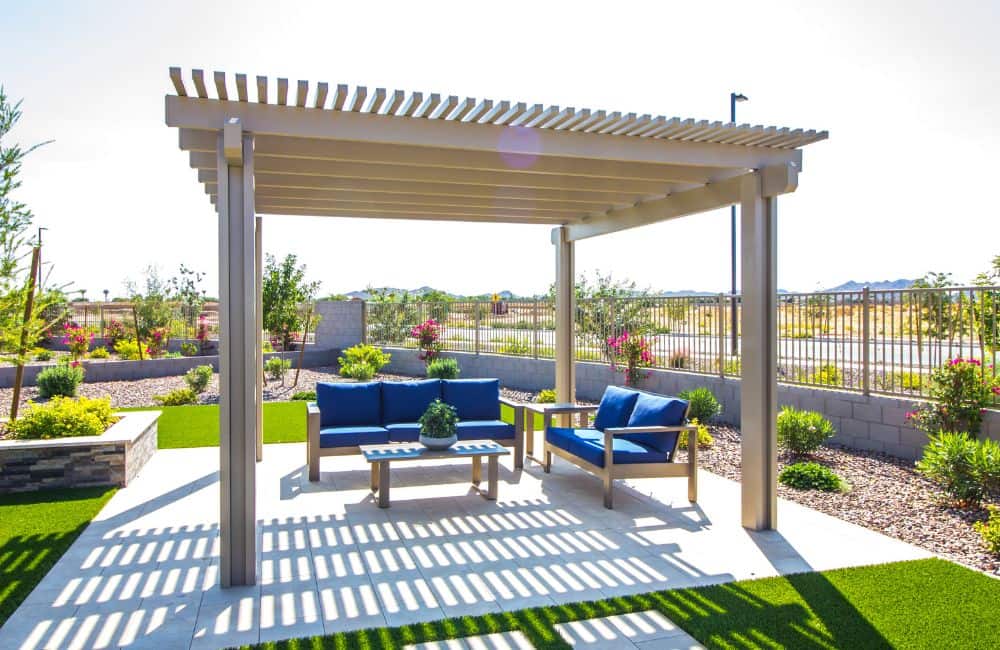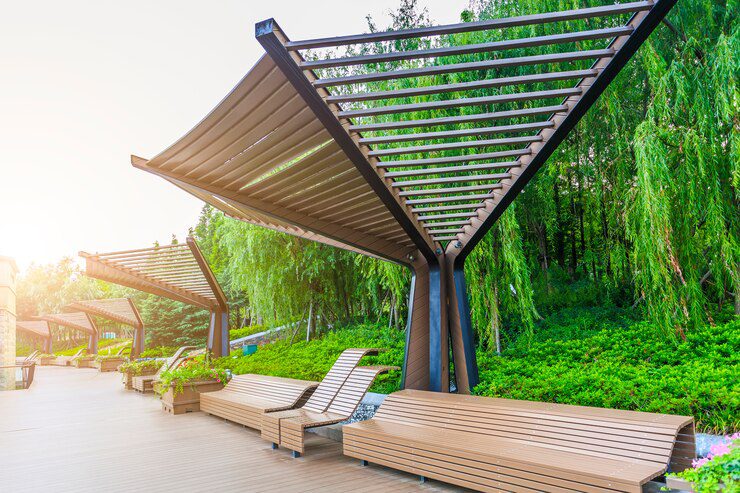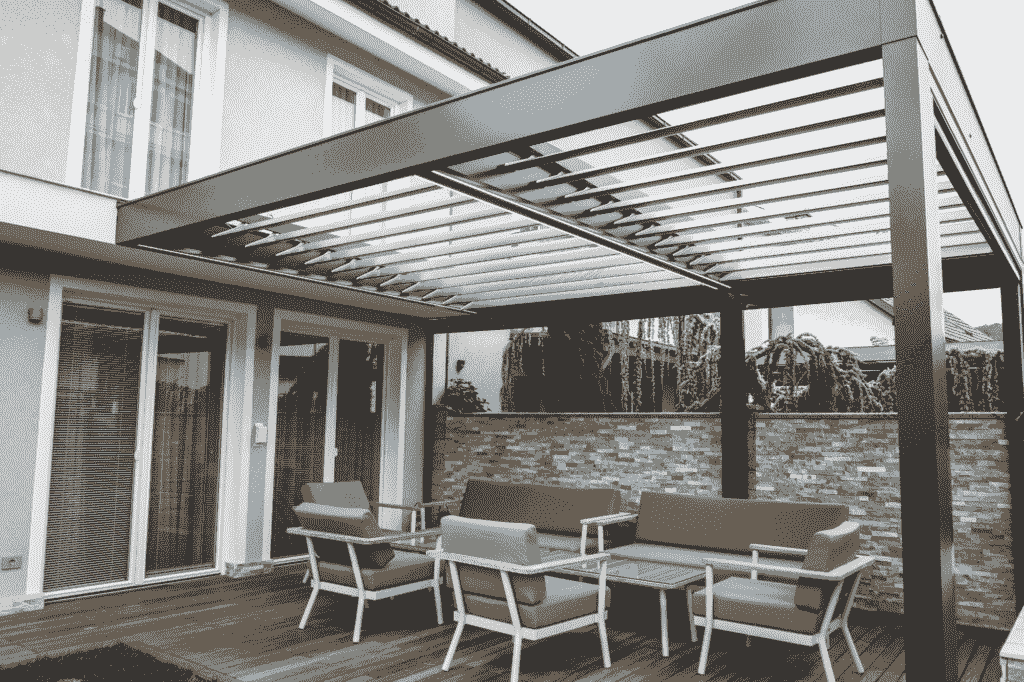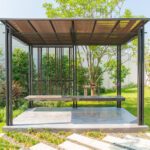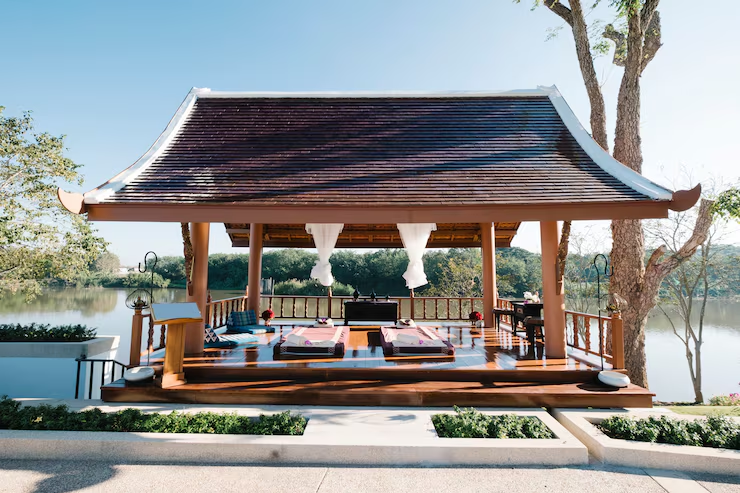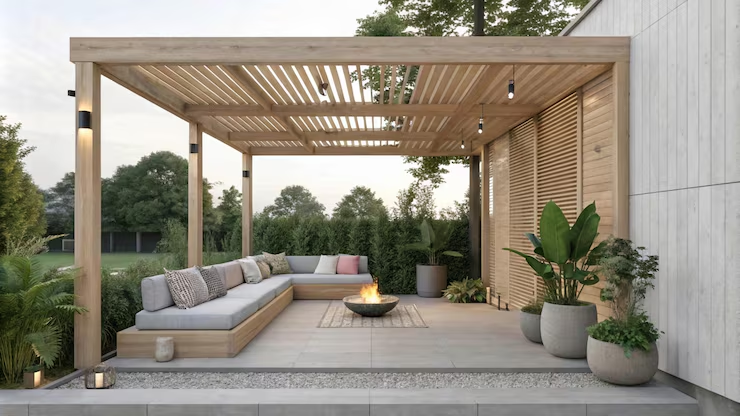Beyond enhancing the visual appeal of outdoor spaces, an outdoor pergola provides functional benefits like shade, privacy, and defined spaces for relaxation and entertainment . The global pergolas market is expected to grow with a Compound Annual Growth Rate (CAGR) of 11.0% from 2024 to 2032, highlighting their increasing popularity among homeowners. However, to maximize its potential, careful consideration of its placement is essential.
Here are the seven key factors to consider when deciding where to place an outdoor pergola in Connecticut.
Table of Contents
What Are the Benefits of an Outdoor Pergola?
Where Should an Outdoor Pergola Be Placed? 7 Key Considerations
- Maximize Shade Where You Need It Most
- Create Defined Zones in a Spacious Backyard
- Take Advantage of Stunning Views
- Establish a Perfect Outdoor Dining Spot
- Enhance Your Garden With Visual Appeal
- Highlight a Fire Pit or Water Feature
- Gain Privacy in Open Spaces
How to Find a Trusted Supplier for Outdoor Pergolas
How to Enhance Your Pergola With Accessories and Features
Elevate Your Outdoor Living with Durkin’s Pergolas!
Key Takeaways
|
What Are the Benefits of an Outdoor Pergola?
An outdoor pergola offers a range of benefits that go beyond aesthetics. Outdoor living spaces offer a tranquil retreat for relaxation and provide a comfortable environment to unwind away from the distractions of gadgets. Here are some reasons why homeowners choose to install pergolas in their backyards:
- Shade Creation: Outdoor pergolas provide partial shade, making them ideal for sunny days without completely blocking natural light. This allows homeowners to enjoy the outdoors comfortably while still experiencing the warmth of natural sunlight.
- Defined Outdoor Spaces: They can help organize backyards by creating zones for specific activities, like dining or lounging. This makes the backyard feel more intentional and easier to navigate during gatherings or daily use.
- Enhanced Property Value: A well-placed outdoor pergola increases the visual appeal and functionality of a home, potentially raising its market value. It can also make the property more attractive to potential buyers who value outdoor living spaces.
- Versatility: Pergolas can be designed to fit different backyard styles and purposes, from modern retreats to garden oases. This adaptability ensures they can suit any space, whether large or small.
- Room for Customization: Adding accessories like lighting, curtains, or climbing plants allows homeowners to personalize their pergolas. These additions can transform a simple structure into a luxurious outdoor sanctuary tailored to individual preferences.
These benefits, however, depend on proper placement. A poorly placed outdoor pergola might not deliver the shade, privacy, or visual appeal expected, making location a critical consideration.
Where Should an Outdoor Pergola Be Placed? 7 Key Considerations
1. Maximize Shade Where You Need It Most
Shade is often the primary reason homeowners install an outdoor pergola. To make the most of its shading capabilities, the pergola should be strategically placed where shade is needed the most, such as:
- Sunny Patios: Installing an outdoor pergola over a patio creates a comfortable seating area while protecting furniture from UV damage. This placement also ensures the patio remains a usable space even during the hottest parts of the day.
- Near Pools: A pergola near a pool offers a shaded spot for relaxation while still allowing proximity to water activities. It also provides a comfortable area to dry off or lounge without direct exposure to the sun.
- Outdoor Play Areas: For families, placing an outdoor pergola near children’s play areas ensures they can enjoy outdoor activities while staying protected from the sun. It also creates a designated spot for supervising children in a shaded, comfortable environment.
To enhance the shading function, homeowners can incorporate features like retractable canopies, adjustable louvers, or climbing plants. Understanding the movement of the sun throughout the day is also crucial to determining the best location for consistent shade coverage.
2. Create Defined Zones in a Spacious Backyard
In large backyards, an outdoor pergola can act as an anchor to define specific spaces. Without proper zoning, vast outdoor areas can feel unorganized and overwhelming. A pergola helps create structure and balance by breaking the space into functional sections. Here’s how it can be used:
- Lounge Areas: Place an outdoor pergola in a corner to create a cozy reading or lounging nook. This provides a designated space for unwinding, separate from busier areas like dining or entertaining spots.
- Dining Areas: Use a pergola to establish a dedicated outdoor dining spot, making mealtime more structured and enjoyable. The pergola can also serve as a natural divider between the dining area and the rest of the backyard.
- Entertainment Spaces: Positioning an outdoor pergola near a fire pit or outdoor kitchen creates a hub for social gatherings. It helps organize activities while offering a shaded or semi-covered area for guests to relax.
By creating distinct zones, a backyard feels more purposeful and organized, making it easier to enjoy various outdoor activities. Additionally, zoning with pergolas adds visual interest by naturally drawing the eye to specific areas.
3. Take Advantage of Stunning Views
Whether the backyard overlooks a garden, a pond, or distant mountains, a pergola can serve as the perfect vantage point. To make the most of the views, consider the following:
- Orientation: Align the pergola to frame the best view, ensuring it becomes the focal point of the outdoor space. Proper alignment can turn a simple pergola into a visually stunning structure that enhances the scenery.
- Height: Adjust the height of the pergola to avoid obstructing the view while maintaining its aesthetic appeal. Taller pergolas can be paired with low-profile furniture to keep sightlines open and unobstructed.
- Openness: Keep the design of the pergola open with minimal beams to avoid blocking sightlines. This not only highlights the view but also ensures the pergola feels airy and inviting.
A pergola positioned with the view in mind transforms the space into a tranquil retreat, making it a favorite spot for homeowners and guests alike. It also creates opportunities for taking in sunsets or starry nights in a comfortable setting.
4. Establish a Perfect Outdoor Dining Spot
Outdoor pergolas create ideal settings for dining al fresco, as they combine shade and ambiance for a comfortable dining experience. To optimize this use, consider these factors:
- Proximity to the Kitchen or Grill: Placing the pergola close to an indoor kitchen or outdoor grill minimizes the effort of carrying food and utensils. This convenience encourages more frequent outdoor meals without the hassle of long trips back and forth.
- Size and Layout: Ensure the pergola is large enough to accommodate a dining table and chairs while leaving room for movement. Proper sizing prevents the space from feeling cramped and allows for additional features like a buffet table or serving cart.
- Accessories: Incorporate string lights, fans, or heaters to make the dining space usable in different weather conditions. These additions ensure the area is comfortable year-round.
An outdoor pergola designed as a dining space encourages more frequent outdoor meals, turning everyday dining into a memorable experience. It also provides an ideal setting for hosting parties or family gatherings with added comfort and style.
5. Enhance Your Garden With Visual Appeal
For garden enthusiasts, an outdoor pergola can serve as both a decorative and functional feature. It blends seamlessly into natural landscapes while providing opportunities to enhance greenery. Here are some ideas:
- Positioning: Place the pergola along garden pathways or as a centerpiece to draw attention to vibrant flower beds. This placement enhances the overall flow of the garden and adds a touch of sophistication to the outdoor space.
- Climbing Plants: Use climbing plants like roses, wisteria, or ivy to integrate the pergola into the garden. Over time, the pergola becomes a living structure filled with greenery and blooms, creating a stunning and dynamic focal point.
- Seating Areas: Add a bench or swing beneath the pergola to create a serene space for enjoying the garden. This encourages homeowners to spend more time outdoors and appreciate their hard work in a peaceful environment.
An outdoor pergola placed in a garden elevates its charm, turning it into a peaceful oasis for relaxation. Additionally, the structure provides opportunities for shade and protection while gardening.
6. Highlight a Fire Pit or Water Feature
An outdoor pergola can anchor and enhance backyard features like fire pits, fountains, or ponds. Placing the pergola near these elements creates a cohesive design that draws attention to these focal points. Consider the following:
- Lighting: Add soft lighting to highlight the feature at night and create a cozy ambiance. Lights also ensure safety around fire pits and water features after dark.
- Decorative Elements: Use curtains or lattice panels to complement the aesthetics of the fire pit or water feature. These additions add depth to the space, making it visually interesting without overwhelming the feature itself.
- Seating: Position chairs or benches under the pergola for a comfortable gathering spot. Arranging seating in this way encourages conversation around the highlighted feature.
This placement ensures the outdoor pergola becomes a gathering hub, adding functionality and visual appeal to the space. It also transforms the area into a multi-purpose spot for entertaining or quiet reflection.
7. Gain Privacy in Open Spaces
For homeowners seeking a more private backyard, an outdoor pergola can act as a stylish barrier. By placing the pergola in areas where privacy is needed, homeowners can create secluded retreats. Here’s how:
- Near Property Edges: Position the pergola near fences or walls to block views from neighboring properties. This not only increases privacy but also helps define property boundaries elegantly.
- Privacy Screens: Enhance the pergola with lattice panels, curtains, or vertical gardens for added seclusion. These features can also double as design elements, as they blend privacy with aesthetics.
- Enclosed Designs: Opt for pergolas with partially covered roofs or sides to create a cozier, more intimate space. Such designs are perfect for relaxation areas or small outdoor offices.
A well-placed outdoor pergola not only provides privacy but also elevates the sense of comfort and security in the backyard. It ensures homeowners can enjoy their outdoor spaces without distractions or intrusions.
How to Find a Trusted Supplier for Outdoor Pergolas
Choosing the right supplier in Connecticut is crucial to ensure the outdoor pergola is durable, functional, and visually appealing. Here are tips to identify a trusted supplier:
- Research Customer Reviews: Look into reviews and testimonials to gauge the supplier’s reliability and quality. Find consistent feedback on product durability and customer service to ensure a positive purchasing experience.
- Choose Material Options Carefully: Opt for suppliers offering durable materials like cedar, aluminum, or vinyl to withstand weather elements. Explore options from suppliers with a wide range of materials for solutions tailored to specific climates and preferences.
- Seek Customization Services: Work with a supplier that provides customizable designs to match specific backyard styles and sizes. Use this flexibility to create a pergola that fits unique aesthetic and functional needs.
- Verify Warranty and Support: Confirm that the supplier offers a warranty and after-sales support for peace of mind. Check for a clear warranty policy that reflects the supplier’s confidence in their products and commitment to customer satisfaction.
- Request Professional Installation: Look for suppliers that include installation services to save time and ensure proper setup. Use professional installers to reduce the risk of structural issues or damage during assembly.
Selecting a trusted supplier like Durkin’s ensures that the outdoor pergola is a long-lasting investment that enhances the backyard. Additionally, a reliable supplier provides valuable advice during the selection and design process, making the overall experience stress-free.
How to Enhance Your Pergola With Accessories and Features
Once the outdoor pergola is in place, adding accessories can transform it into a functional and personalized space. These additions make the outdoor pergola a true extension of the home, ideal for relaxation and entertainment. Here are some enhancement ideas:
- Retractable Canopies: Protect against rain and sun while maintaining flexibility. These canopies also allow homeowners to adjust the pergola’s coverage based on changing weather conditions or their desired level of light.
- Lighting Fixtures: String lights, lanterns, or LED strips create a warm and inviting atmosphere. Incorporating dimmable lighting adds versatility, making the pergola suitable for both lively gatherings and quiet evenings.
- Furniture: Incorporate comfortable seating or dining sets for practicality. Weather-resistant furniture ensures longevity and keeps the space functional regardless of seasonal changes.
- Plants and Greenery: Decorate with climbing vines or potted plants for a natural look. Choosing plants with seasonal blooms adds dynamic color and texture throughout the year.
- Heating or Cooling Solutions: Add heaters or fans for year-round comfort. Combining these with retractable curtains or panels can create a more enclosed and climate-controlled environment.
Frequently Asked Questions
What is the difference between a pergola and a gazebo?
A pergola is an open structure with a lattice-style roof, providing partial shade while allowing some sunlight to filter through. A gazebo, on the other hand, is fully enclosed on top, offering complete shelter from the sun and rain. Pergolas are often used for decorative purposes, while gazebos serve as more functional outdoor shelters.
Can pergolas be attached to a house?
Yes, pergolas can be attached to a house, creating a seamless flow between indoor and outdoor spaces. They are often installed over patios or decks to provide shade and a stylish extension of the home’s architecture. Attached pergolas also offer the advantage of utilizing existing walls for support, reducing installation costs.
What is the best material for a pergola?
The best material for a pergola depends on your climate, maintenance preferences, and desired style. Wood offers a natural, rustic look but requires regular upkeep to prevent weather damage. Vinyl and aluminum are low-maintenance options, with vinyl being cost-effective and aluminum being highly durable and lightweight.
How do you maintain a pergola?
Maintaining a pergola involves regular cleaning to remove dirt, leaves, and debris that may accumulate on the structure. Wooden pergolas should be inspected annually for signs of rot or damage and resealed or repainted as needed. For vinyl and aluminum pergolas, simply washing with water and a mild detergent keeps them looking clean and fresh.
Can a pergola have a solid roof?
Yes, a pergola can have a solid roof for additional protection from the elements. Solid roofs, made of materials like polycarbonate or metal, shield the space underneath from rain while providing full shade. Adding a solid roof can enhance the pergola’s usability year-round, making it suitable for diverse climates.
Elevate Your Outdoor Living with Durkin’s Pergolas!
Ready to enhance your backyard with the perfect outdoor pergola? Trust Durkin’s, a leading pergola supplier and installer based in Connecticut, to bring your vision to life. With over 100 years of expertise, Durkin’s specializes in crafting high-quality pergolas tailored to fit your style and outdoor needs. Durkin’s in Connecticut offers top-notch materials, customizable designs, and professional installation services.
Don’t wait to elevate your outdoor living experience—contact Durkin’s today and let our Connecticut team turn your backyard dreams into reality!

